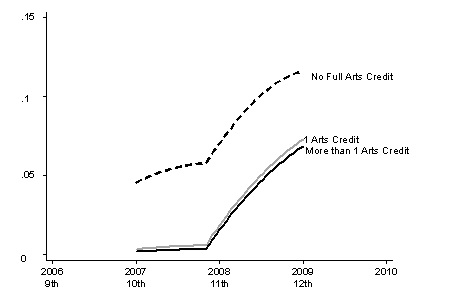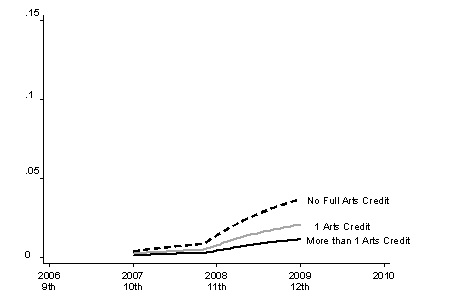By M. Kathleen Thomas
Student enrolment in public school courses in visual art, music, theatre, and dance is linked to reduced high school dropout even after controlling for observable student and school characteristics expected to influence both arts participation and school commitment. Agencies that support arts education should invest in experimental studies to produce causal evidence about the impact of arts on the student outcomes stakeholders care about.
Dropping out of high school remains a significant public education problem in the United States because the associated costs of doing so are extremely high and borne predominately by low-income and minority students, not to mention society at large. Promising interventions often center on student engagement. Using administrative data from Texas public high schools, we explore whether student enrollment in courses in visual arts, music, theatre, and dance are linked to reduced dropout behavior. Quality programs in the arts provide youth with student-centered, collaborative, active learning experiences that are inherently creative. If arts courses can engage at-risk students in ways that improve their socio-emotional development and connection to school, then making the right investments in public school arts programming could be a useful tool in reducing high school dropout.
Figure 1: Unconditional smoothed hazard rate estimates for time to first dropout by arts credits
Source: University of Texas at Dallas Education Research Center.
My colleagues and I follow a cohort of first-time 9th graders for five years beginning in 2006. Using survival analysis, we find that students who enroll and complete courses in the arts face a lower risk of dropping out compared to similar non-arts students. There are two levels of selection bias we attempt to address. First, the availability of arts programming in Texas public high schools is far from random. We document in an earlier study that access to both the number and variety of courses in visual arts, music, theatre, and dance in Texas public high schools is highly correlated with school characteristics such as wealth and the racial make-up of the school. We address this school-level selection problem in the model. However, there is another level of selection at play here—the students who choose to enroll in arts courses while in high school. The arts students in the cohort we follow tend to be higher-income, non-minority students who attend high schools with few low-income students. While the data allow us to control for a wide set of student and school characteristics we expect to influence both arts enrollment and the decision to drop out of high school, it is likely that a student’s decision to take a course in the arts is at least partly explained by information not available in a state education database. We do not observe motivation, artistic ability, the availability of private instruction, or support for the arts in the home, for example.
Figure 2: Conditional smoothed hazard rate estimates for time to first dropout by arts credits (time constant coefficients)
Source: University of Texas at Dallas Education Research Center.
Despite our inability to assert causality, our findings represent a significant step forward in the field precisely because we uncover an effect after controlling for a rich set of student and school characteristics and employing more rigorous statistical methods. A plausible outcome could certainly have been that a selection on observables model with strong data would simply reveal any estimated impact to be zero. While the risk of dropping out diminishes substantially once we control for the student and school characteristics available in the data, it does not vanish. A causal mechanism remains a possibility.
One can ask why this line of inquiry is even necessary. Why do we need causal evidence that arts education improves student outcomes? The general public overwhelming supports a place for the arts in public schools in the United States. The arts are considered part of a well-rounded education and codified as such in the Every Student Succeeds Act signed into law by President Obama last year. Yet, as the most recent recession demonstrated to us once again, the arts are usually the first subjects to be cut, downsized, or restructured when U.S. schools face severe budget cuts. Rigorous evidence about the efficacy of arts education programs will help school administrators understand the true consequences of eliminating arts programming in their districts. Causal evidence can also assist administrators at well-funded public schools as they try to determine the best way to spend limited resources to improve the education of their students. To shape policy and inform the decision-making of arts educators and administrators, researchers in the field need to invest in experimental studies that can provide strong evidence about what works and what doesn’t in public schools, particularly for underserved students.
—This research was funded by a generous grant from the Spencer Foundation.
This article is based on:
Arts Education and the High School Dropout Problem. 2015. With Priyanka Singh and Kristin Klopfenstein. Journal of Cultural Economics, 39 (4): 327-339, DOI: http://link.springer.com/article/10.1007/s10824-014-9238-x.
Access to High School Arts Education: Why Student Participation Matters as Much as Course Availability. 2013. With Priyanka Singh, Kristin Klopfenstein and Thomas C. Henry. Education Policy Analysis Archives, 21(83), DOI: http://dx.doi.org/10.14507/epaa.v21n83.2013.
Author information:
M. Kathleen Thomas, Department of Finance and Economics, Mississippi State University.
Image source:
M. Kathleen Thomas.



Where is poetry ? Art is not what you eat at television
LikeLike